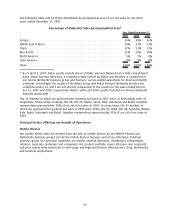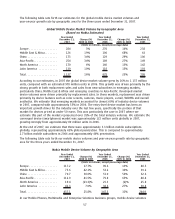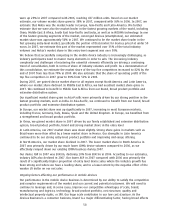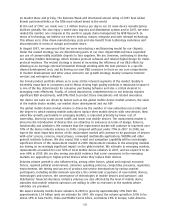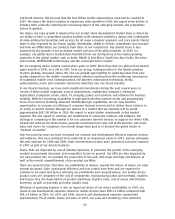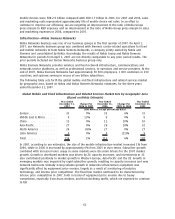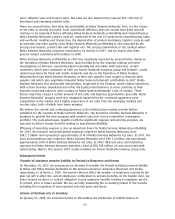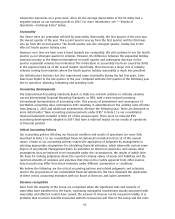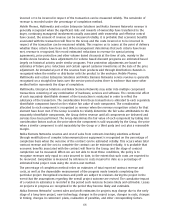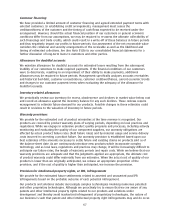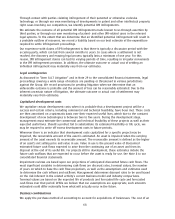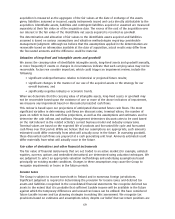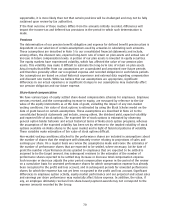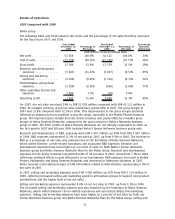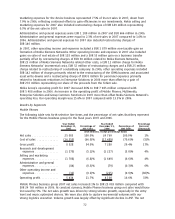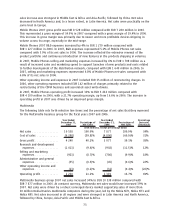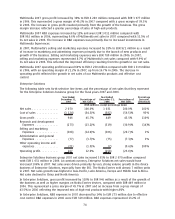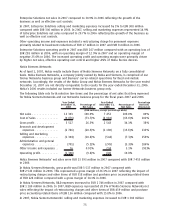Nokia 2007 Annual Report Download - page 67
Download and view the complete annual report
Please find page 67 of the 2007 Nokia annual report below. You can navigate through the pages in the report by either clicking on the pages listed below, or by using the keyword search tool below to find specific information within the annual report.incurred or to be incurred in respect of the transaction can be measured reliably. The remainder of
revenue is recorded under the percentage of completion method.
Mobile Phones, Multimedia and certain Enterprise Solutions and Nokia Siemens Networks revenue is
generally recognized when the significant risks and rewards of ownership have transferred to the
buyer, continuing managerial involvement usually associated with ownership and effective control
have ceased, the amount of revenue can be measured reliably, it is probable that economic benefits
associated with the transaction will flow to the Group and the costs incurred or to be incurred in
respect of the transaction can be measured reliably. This requires us to assess at the point of delivery
whether these criteria have been met. When management determines that such criteria have been
met, revenue is recognized. We record estimated reductions to revenue for special pricing
agreements, price protection and other volume based discounts at the time of sale, mainly in the
mobile device business. Sales adjustments for volume based discount programs are estimated based
largely on historical activity under similar programs. Price protection adjustments are based on
estimates of future price reductions and certain agreed customer inventories at the date of the price
adjustment. An immaterial part of the revenue from products sold through distribution channels is
recognized when the reseller or distributor sells the product to the enduser. Mobile Phones,
Multimedia and certain Enterprise Solutions and Nokia Siemens Networks service revenue is generally
recognized on a straight line basis over the service period unless there is evidence that some other
method better represents the stage of completion.
Multimedia, Enterprise Solutions and Nokia Siemens Networks may enter into multiple component
transactions consisting of any combination of hardware, services and software. The commercial effect
of each separately identifiable element of the transaction is evaluated in order to reflect the
substance of the transaction. The consideration from these transactions is allocated to each separately
identifiable component based on the relative fair value of each component. The consideration
allocated to each component is recognized as revenue when the revenue recognition criteria for that
element have been met. If the Group is unable to reliably determine the fair value attributable to the
separately identifiable components, the Group defers revenue until all components are delivered and
services have been performed. The Group determines the fair value of each component by taking into
consideration factors such as the price when the component is sold separately by the Group, the price
when a similar component is sold separately by the Group or a third party and cost plus a reasonable
margin.
Nokia Siemens Networks revenue and cost of sales from contracts involving solutions achieved
through modification of complex telecommunications equipment is recognized on the percentage of
completion basis when the outcome of the contract can be estimated reliably. This occurs when total
contract revenue and the cost to complete the contract can be estimated reliably, it is probable that
economic benefits associated with the contract will flow to the Group, and the stage of contract
completion can be measured. When we are not able to meet those conditions, the policy is to
recognize revenues only equal to costs incurred to date, to the extent that such costs are expected to
be recovered. Completion is measured by reference to costs incurred to date as a percentage of
estimated total project costs using the costtocost method.
The percentage of completion method relies on estimates of total expected contract revenue and
costs, as well as the dependable measurement of the progress made towards completing the
particular project. Recognized revenues and profit are subject to revisions during the project in the
event that the assumptions regarding the overall project outcome are revised. The cumulative impact
of a revision in estimates is recorded in the period such revisions become likely and estimable. Losses
on projects in progress are recognized in the period they become likely and estimable.
Nokia Siemens Networks’ current sales and profit estimates for projects may change due to the early
stage of a longterm project, new technology, changes in the project scope, changes in costs, changes
in timing, changes in customers’ plans, realization of penalties, and other corresponding factors.
66


